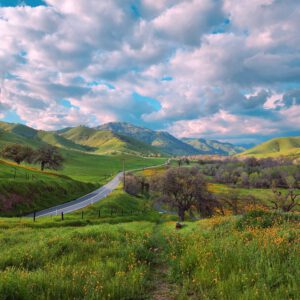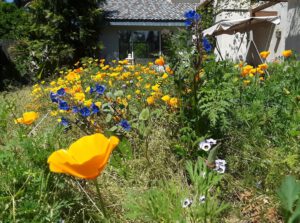
Following weeks of record rainfall, Central Valley residents need little urging to get outside now that the wettest weather ever is mostly behind us. Mother Nature is giving us one anyway. An intense superbloom is covering the state’s hillsides and deserts in blankets of wildflowers.
And the showy display is turning the Sierra Nevada into a riot of color and floral perfumes. Masses of flowers are also blossoming on the nearby coastal ranges. But there’s no need to travel across the state. The superbloom is happening in our wildlands and open ranges.
Wildflowers Enjoying End of Drought
While there’s no technical definition of a superbloom among botanists, what Californians are witnessing right now is the sudden and intense end of the years-long drought that continues to plague parts of the Western US. According to the National Drought Mitigation Center at the University of Nebraska-Lincoln, only two small regions in the far north and south of the state are still experiencing abnormally dry conditions trending into moderate drought.
It’s been four years since the Golden State saw real rainfall – enough to trigger the superbloom of 2019 – and during the dry years since, wildflower seeds have been lying dormant awaiting a return of regular precipitation.
They got it this year and then some. Thirty-three total atmospheric river events hit the state starting in November, according to the National Weather Service. The Tulare-Buena Vista Lakes Region – which includes a swath of the Central Valley from Bakersfield and Wasco north to the Fresno Air Terminal – have seen between 157% and 216% of the average annual average.
There are still four months left in the “water year” that ends in September, just in time for the next rainy season to start. The snowpack, which hit nearly triple its annual average, should also be done melting by then. Probably. Temperatures this spring have been mostly below the average.
All of that means all those dried out seeds are growing as fast as they can. All the usual popular spots statewide are busy. But there’s no reason to leave home to see them.
Stay Home for the Superbloom
 There are several areas the state’s Department of Parks and Rec recommends for viewing the superbloom, but most of them are several hours or more away by car. But there are exceptions. To the south in Kern County is the Eastern Kern County Onyx State Vehicular Recreation Area on the edge of the Mojave Desert. A bit closer is the Tule Elk State Nature Reserve, southwest of the junction of the I-5 and the Stockdale Highway in Buttonwillow.
There are several areas the state’s Department of Parks and Rec recommends for viewing the superbloom, but most of them are several hours or more away by car. But there are exceptions. To the south in Kern County is the Eastern Kern County Onyx State Vehicular Recreation Area on the edge of the Mojave Desert. A bit closer is the Tule Elk State Nature Reserve, southwest of the junction of the I-5 and the Stockdale Highway in Buttonwillow.
In Earlimart, the superbloom can be enjoyed at Colonel Allensworth State Historic Park.
The jewel of the Valley during superblooms is also one of the most popular in the state: Carrizo Plain National Monument near tiny Santa Margarita in the hills due west of Bakersfield. But time is running out. So says the Thomas Payne Foundation for Wildflowers and Native Plants, which tracks superblooms when they happen.
“The pleated slopes of Carrizo Plain National Monument are colored yellow with wildflowers,” the foundation reported on April 14. “Visit soon as the region is beginning the downside of peak bloom. Places with the best views are along Elkhorn Road, Elkhorn Grade Road and Soda Lake Road.”
The foundation’s website – theodorepayne.com – updates the state’s superblooms while the colorful outburst lasts.
Gems of the Sequoia Riverlands Trust
These very popular sites are close to home – none farther than about a two-and-a-half-hour drive – but there are less well-known and less crowded spots even nearer.
According to Aaron Collins, communications director for the Visalia-based Sequoia Riverlands Trust (SRT), they’ve got enough blooms to satisfy any day-tripping lover of sudden, uncontrolled botanical outbursts.
“Blue Oak Ranch Preserve, Dry Creek Preserve and Homer Ranch Preserve are open to the public,” he said. “Anyone can enjoy the superbloom just a short drive from Tulare County’s cities.”
And, yes, they can hold their own against more visited and publicized locations.
“Our preserves in the Sierra Nevada foothills are currently blowing up with wildflowers,” Collins said.
Rena Fagundes, a frequent visitor to many of SRT’s preserves, recommends Dry Creek Preserve in particular.
“I’m going for the blooms, and they have tiny mini-butterflies,” she said. “I like this one (Dry Creek) most.”
Dry Creek and Homer Ranch preserves are located northwest of Woodlake near Highway 198 on Dry Creek Drive. The Sopac McCarthy Mulholland Blue Oak Ranch Preserve is located on 900 acres about five miles north of Springville on Harris Road.
Rare Wetlands Walk for the Public
The only open SRT preserve not getting entirely into the act is the Kaweah Oaks Preserve north of Exeter on Road 182.
“Kaweah Oaks Preserve, on the other hand, is typically wildflower-free except for a few only moderately showy species, like alkali heliotrope,” Collins said.
Another SRT preserve not known for its wildflowers is the James K Herbert Wetland Prairie Preserve at the intersection of Farmersville Boulevard (Road 168) and the Tulare-Lindsay Highway. The Herbert is a haven for vernal pools and the animals that rely on the Valley’s shrinking wetlands to survive.
Normally closed to the public because of its sensitive ecology, the Herbert Preserve will be open from 9 a.m. to 1 p.m. this Saturday, April 22. The pools are located about a 20- to 30-minute walk over uneven ground from the road. The event is self-guided, but docents will be on hand to answer questions and provide information.
A donation of $15 is requested for adults who aren’t SRT members. Reservations are recommended, though they are not required. RSVPs can be made at sequoiariverlands.org.

We are blessed to have all this natural beauty literally within a short drive away.